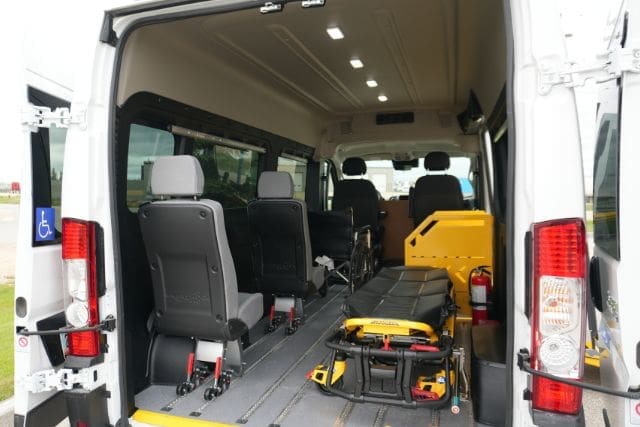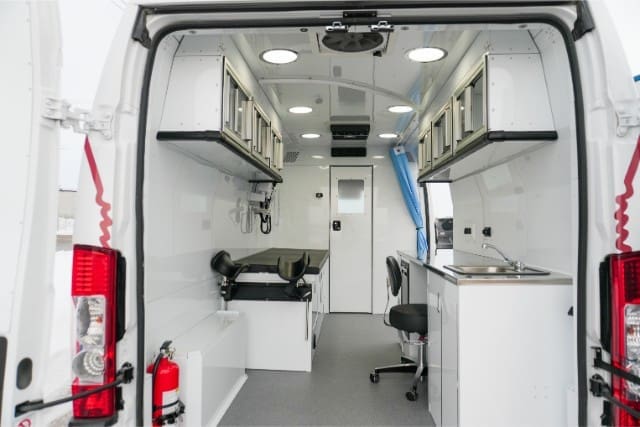Generally, people like to be on time for things.
Whether for doctor’s appointments, community outings, or events with family members, being on time provides a level of comfort when traveling.
So, what happens when you don’t have control over when you are picked up to go to an appointment, outing, or event? What happens if your passengers miss important engagements?
Feelings of stress, disappointment, and isolation can occur.
As we’re sure you might know, when you use a third–party wheelchair van for transportation, schedules turn into guessing games. But even if that’s the case, is owning a wheelchair van the best option for your organization?
In this article, you’ll learn the pros and cons of owning vs. using a third party wheelchair van, so that you can decide which option is right for you.
At MoveMobility, we often hear clients’ frustration about their lack of control when using third party transportation. That being said, we also hear about the strengths of using third party transportation, especially for organizations with a smaller budget.
So, in this article, we promise to give you an honest overview of the strengths and weaknesses of both options. First, you’ll learn the major difference between the two.
Owning vs. using a third party wheelchair van for transportation: what’s the difference?
When you own a wheelchair van, you have full control over what time you leave, where you’re going, when you arrive, and the amount of maintenance the accessible vehicle receives.
When you use third party transportation, you plan for the transportation to arrive at a certain time but it’s never guaranteed that they will arrive on time or get you to where you need to go on time. You have no control over the amount of maintenance the accessible vehicle receives.
Third party transportation can be services like accessible taxis, transit services, and local handivans.
What does this mean for your organization? Read on to find out.
Using a third party wheelchair van for transportation–what are the pros?
There are two advantages to using third party transportation: the simplicity of the service, and the fact that it is less responsibility for your organization.
1. The simplicity of the service they provide
When you choose to go with third party transportation, you’ll likely notice how simple the structure of the service is–you pay a fee each month, and you have access to an accessible vehicle.
2. Less responsibility for your organization
Using third party transportation also means you don’t have to take the vehicle in to be serviced, you don’t have to pay for repairs, and you don’t have to worry about taking proper maintenance precautions such as getting the oil changed.
You also don’t have to find a driver (with a specialized license if you’re using a bus), and overall, you require less staff because you’re not operating a large vehicle.
Now that we’ve covered the advantages of using third party transportation, let’s dive into the weaknesses.
Using a third party wheelchair van for transportation–what are the cons?
The main weakness of using third party transportation is simply the lack of control you have, both in the reliability and quality of service, and the vehicle you get.
No control over the timeliness/reliability of the service they provide
When you choose to use third party transportation, you don’t have control over when passengers are picked up/dropped off. This can be extremely inconvenient for organizations because it makes planning/scheduling a nearly-impossible task.
Less control over the quality of service they provide
With third party transportation, what you get is what you get.
You have no control over the maintenance and cleanliness of the vehicle.
You also have no control over who is driving the vehicle. This can result in a lack of compassion from drivers–and compassion, when transporting a vulnerable group of people, is extremely important.
Less control over what kind of vehicle you get
Again, with third party transportation, what you get is what you get.
This means you have a lack of control over the kind of vehicle you get. If you’re an organization that needs to transport passengers with varying mobility, you’ll likely find it difficult to find something that suits all of your passengers’ needs.
Imagine this: you’re trying to get to a doctor’s appointment and you use a walker. The bus shows up, but it has a lift. You feel intense anxiety at the thought of being suspended 3 feet in the air, so you decide not to use the bus–and miss the appointment altogether.
In this example, the passenger who uses a walker would need a ramp instead of a lift–something they could customize by owning an accessible vehicle–so that they can walk up the ramp.
When you have less control over what kind of vehicle you get, the vehicle may not be the right fit for your passengers. They could end up missing important engagements–such as doctor’s appointments–and they will have fewer opportunities to participate in group outings.
This could result in feelings of loneliness and isolation. How your passengers feel while using the accessible vehicle is very important because we want to encourage inclusivity and pay attention to the humanity of those riding with us.
Although the third party system is common all over Canada, communities have no control over how the system is being operated. At MoveMobility, our team has regularly seen that third party transportation services are very slow to address challenges and make changes.
Although using third party transportation may seem like the easiest option at first, it can end up costing a community more than money in the long term.
Now that you know the pros and cons of using third party transportation, you may be wondering what the pros and cons are of owning a wheelchair van. Read on to find out.
Owning a wheelchair van–what are the pros?
Owning your accessible vehicle has two main strengths, and they both involve the level of control you get–both in the quality of service you provide to your passengers and in the customization of your vehicle.

You control the quality of service
When you own your vehicle, you control who you hire to drive the vehicle. That means you get to specifically hire someone compassionate–which, as we’ve talked about, is extremely important when transporting vulnerable passengers.
You control the vehicle you get
We already dove into this, but in case you forgot, passengers with different mobility needs require different methods of getting in and out of the accessible vehicle.
Someone who uses a walker may only be comfortable using a ramp.
And someone with a larger wheelchair may only be comfortable using a lift.
When you own your vehicle, you get to customize that vehicle to fit any of your passengers’ needs. You even get to customize the layout of the inside of your van to specifically fit a certain number of wheelchairs and a certain number of walk-on passengers.
You can use the van when you want
When you own your vehicle, your programs don’t rely on the availability of a transportation company’s vehicle. You get to use the van when you want, where you want. Planning your program’s day becomes a lot easier.
Now that you know the strengths of owning your accessible vehicle, let’s dive into the weaknesses.
Owning a wheelchair van–what are the cons?
There is only one major con to owning your accessible vehicle: the level of responsibility your organization has to maintain the vehicle.
More maintenance responsibility for your organization
When you own a vehicle, it’s your responsibility to maintain that vehicle. This means you will have to regularly service your wheelchair van–whether that’s for oil changes, ramp or lift inspections, or repairs if something breaks down.
You may also have to hire a driver and other staff to help load/unload passengers from the vehicle.
Your next steps to knowing if you should keep using a third party wheelchair van for transportation
You came to this article to learn whether you should own a wheelchair van or use third party transportation.
Now, you know the pros and cons of each option–and maybe you even know which option is right for you.
But if you’re still not sure, talk to a MoveMobility expert now.
Or, check out these related articles for more information:








